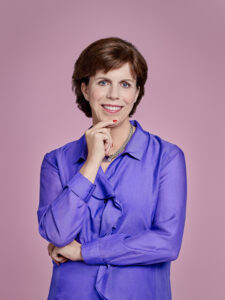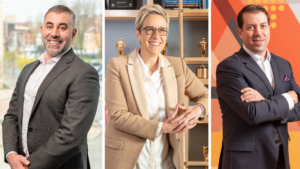In a realm traditionally dominated by a handful of large conglomerates, there is a radical outlier that dares to challenge the status quo. Enter Butler/Till, an independent, results-driven, innovative marketing agency—not only for the work they do, but also how it gets done—that stands as a beacon of empowerment and inclusion with measurable results to match.
Co-founded by Tracy Till and Sue Butler in 1998, the New York-based agency of over 300 employees in nearly 20 U.S. states has consistently been ranked as a top workplace for a decade-and-a-half while boasting 28% year-over-year financial growth.
The agency’s unique ability to catalyze outsized results for clients and partners such as Pfizer, Bristol Myers Squib, and State Farm can largely be attributed to its innovative, purpose-driven operating structure.
Founded on the principles of collaboration, equality, and sustainability, the agency is 100% employee-owned (ESOP), which the company believes creates a radical sense of ownership in its work. Additionally, as a women-governed and led agency, Butler/Till is focused on creating a more inclusive and equitable workspace and world. To that end, the agency is consistently listed on AdAge’s ‘Best Places to Work’ list—including in 2023—and was recognized as one of the ‘fastest-growing women-owned businesses in the U.S.’ by the Women Presidents’ Organization.
Lastly, as an organization that is dedicated to making a positive impact on society and the environment, the agency received Certified B Corporation status in 2015 and is one of only ~4,000 B Corps in the world, which must meet the highest standards of verified social and environmental performance, public transparency, and legal accountability to balance profit and purpose.
“Having worked with Butler/Till for almost nine years, I can say with authority that they are a one-of-a-kind media agency,” says Taylor Simons, SVP at Audigent, a leading data activation, curation, and identity platform. “Butler/Till conducts business in a way that is both honorable and ambitious [and they] retain top talent and clients far above industry standards while also growing exponentially and consistently year over year.”

Behind the scenes, the driving force that propels Butler/Till’s remarkable growth lies within the ability of the company’s board of directors and executive leadership team. This dynamic group of individuals with diverse expertise and industry acumen steer the agency’s strategic direction, foster a culture of innovation, and ensure that the values of employee ownership, women leadership, and B Corp certification are upheld at every level of the organization. And most uniquely, Butler/Till’s board of directors is completely comprised of women, as well.
“I have found Butler/Till to be quite different than many of the environments that I have worked in, which have traditionally been very large, publicly held companies,” says board chair, Kathleen Brookbanks. “The leadership team here has a deep sense of caring about the future of the company, and you sense that they put that ahead of their personal career goals.”
Ms. Brookbanks, who joined Butler/Till’s board in 2020 and was elevated into the chairperson role in 2021, is quick to point to the company’s cohesive leadership team as a catalyst for their consistent growth.
“Every member of the executive team has a vested interest in the agency’s success, with ownership rights that create a sense of collective responsibility and dedication,” says Ms. Brookbanks.
“This dynamic empowers every employee to not just contribute their skills and ideas, but to actively shape the agency’s future.”
A UNIQUE MODEL
Leading that charge toward the future is Butler/Till CEO Kimberly Jones. Since joining Butler/Till nearly 15 years ago, Ms. Jones has made an outsized impact on the company’s trajectory.
Under her leadership, Butler/Till attained its Certified B Corporation status; transitioned to a 100% employee-owned company; achieved double-digit, year-over-year revenue growth for the last 10 years; and has continued to earn recognition as a top workplace for the past 15 consecutive years.
“I must credit our founders, who were the ones who started our culture; one where people can bring their whole, authentic selves into the work they were doing, which is more than just a job,” says Ms. Jones, who held leadership roles at Bausch + Lomb and advertising giant McCann Erickson prior to joining the agency in 2009. “It creates a community and I feel like in many ways I’ve just continued to nurture it and to help it flourish over time.”
Now in their 11th year as an employee-owned company, Ms. Jones recalls the early days of acclimating employees to an ESOP model, and the greater sense of responsibility that arose when employees became shareholders.

“We had to do some education about what it meant to be employee owned and what rights our employee-owners had in the decision-making for the company,” says Ms. Jones, who said the greater transparency created an environment of accountability through every facet of the organization.
“It’s almost as if the leadership hierarchy is flipped upside down—I report to the board, but the board reports to all of our shareholders…which happen to be our employee-owners,” she says.
“Our board feels that same sense of responsibility; when considering decisions for the company, we really are thinking about the livelihoods of over 300 employee-owners.”
Given Butler/Till’s distinct operating structure, it only makes sense that the dynamic between the board of directors, Ms. Jones, and her executive team is unique as well.
“When I think about our role as a board, we of course provide oversight on fiscal responsibility and governance, but we are also very focused on Kimberly’s success,” says Ms. Brookbanks.
“The paradigm then shifts to become: how do we help you succeed? Whether that means providing the executive team with the investments and resources they need, or supporting them through difficult decisions, we collectively see our mission as helping Kimberly and the team achieve our very high expectations.”
If Ms. Brookbanks envisions her role as being a conduit for the executive team’s success, then Ms. Jones applies that same calculus toward Butler/Till’s 300+ employee-owners.
“In an employee-owned company, it is critical that every employee-owner feels like they have a voice—and we even use ‘VOICE’ as an acronym for our values: Visionary, Ownership, Integrity, Community, and Extraordinary,” says Ms. Jones. “To take stock of our effectiveness, we survey our employee-owners once a year. Although many companies do this as well, I don’t think all companies take the next step of developing a concrete action plan to improve employee engagement scores in the areas where employees may be feeling underrepresented or undervalued.”
This people-centered approach extends not only to the employee-owners but also to the environment and communities in which they live and work.
In 2015, Butler/Till acquired Brand Cool, an agency recognized as an innovator in clean energy, energy efficiency and sustainability engagement, which had pursued and achieved B Corp status two years prior in 2013. Ms. Jones, who attended the B Corp Champions Retreat—a marquee gathering of the community of Certified B Corporations in the U.S. & Canada—shortly after the acquisition, soon experienced her own epiphany.
“I suppose that was when I drank the Kool-Aid,” she says. “I saw other for-profit businesses genuinely committed to applying business for good, and it has helped our company in numerous ways. From bolstering our culture to attracting top talent, and even on the client and vendor side, it is an important designation for people and organizations who share our values.”
The Future is (Still) Female
And yet, as Ms. Jones speaks of a higher calling in her work, she is also keenly aware of where progress still needs to be made.
In 2023, for the first time in the Fortune 500 list’s 68-year history, 10% of Fortune 500 companies were led by women. As Fortune notes, that number had hovered around 8% for many decades.
“For every appointment, there was a resignation; in such a small universe, every corporate move counts,” notes the magazine.
Although there exists a lack of female representation at the executive level, the same cannot be said about performance. According to the National Women’s Business Council, women entrepreneurs who receive VC funding generate over twice as much in revenue per dollar invested as male entrepreneurs—and generate 10% more revenue over five years. However, TechCrunch reports only 1.9% of women-only teams seeking VC investments got funded in 2022, while about 80.9% of men-only teams received funding.
“I recently had a conversation with the portfolio manager of a woman-led fund who intentionally looks for female founders or unrepresented or underrepresented founders because she finds that those companies are often undervalued,” says Ms. Jones. “It creates competitive differentiation because not everyone has figured out that women and minority-led businesses can outperform their counterparts, which creates an opportunity, especially if you happen to be an investor.”
Insofar as how a women-led leadership structure is a departure from the norm, Ms. Brookbanks says, “I began my career in the 1980s as a woman at a large, publicly-held, male-dominated organization. What I noticed most about Butler/Till’s women-led structure, and in particular, Kimberly’s leadership paradigm, is that she genuinely wants to hear from her leadership team and the board. There is a sense of community here—one that is open to conversation, and it permeates throughout the organization. That is quite different. I do not observe the self-motivated, personal agendas that I would often recognize at the executive level previously in my career.”
Eschewing personal agendas, says Ms. Brookbanks, does not connote a sense of apathy or motivation.
“A genuine sense of caring about the future of the company, and the belief that it is directly tied to their personal success, is not a question of ambition, and it is inspiring to see that it is possible.”
Perhaps surprisingly, some of the strongest advocates for the company’s women-led leadership model are the men within Butler/Till.
“No matter how you measure an organization—whether it is by revenue, operating profit or employee engagement—our trajectory has been incredible,” says chief operating officer, Mike Della Porta, who joined the firm 17 years ago and has helped drive the agency’s impressive growth. “Our founders created an organization with the idea that employee-owners can have a great career and not sacrifice family. That mentality permeates the culture to this day and Kimberly Jones is such a strong example of how to share yourself at work, with your family, and with your community.”
Additionally, says Mr. Della Porta, despite a slew of challenges imposed by supply-chain issues, market instability, and disruptions from the pandemic, Butler/Till was well positioned for steady growth for several reasons.
“The combination of being a women-led, employee-owned B Corp ensures our priorities are in the right place, which contributes to our financial success,” says Mr. Della Porta, who says analysts that evaluate businesses purely by their financial hydraulics are, “missing the boat for what could be sustainable, predictable growth over time.”
And yet, a natural question arises: How does a high-performing organization like Butler/Till balance growth and financial momentum with their long-term sustainability goals as a certified B Corp? According to the agency’s chief financial officer, Scott Chapman—who joined the firm in 2021—the question is not without merit.
“Admittedly, when I first started exploring the opportunity of joining Butler/Till with Kimberly, it was one of my top questions, because I expected there was going to be natural conflict,” says Chapman, who spent over a decade in senior financial roles within the agency sector.
–“It starts with a strategic plan,” he continues. “We mapped out the next five years in order to plot where we want to strategically grow as an agency, and we ensure alignment between our growth, B Corp status, and our values.”

Beyond B Corp alignment, protecting Butler/Till’s strong dynamic corporate culture is yet another area where the executive leadership team has taken a stand.
“We had to terminate a relationship with a client whose revenues exceeded $1 million (USD) because they didn’t treat our employees properly,” says Chapman. “We didn’t agree with the values they had and how they aligned with our company—and we saw the path that we would be on if we retained that client. We believe in the values that we stand behind, which compels us to make the right decision on behalf of our employees.”
AUTHENTICITY RULES
Despite the tremendous effort invested by Butler/Till to create a unique and dynamic corporate environment, the company’s efforts would be for naught if authenticity was not a key component of the agency’s DNA—which it very much is.
As both an employee-owner and the company’s chief marketing officer, Amanda Devito is keenly aware of the impact diversity, equity, inclusion, and belonging (DEIB) have had on the company in recent years. Ms. Devito, who joined the company in 2011, became CMO of Butler/Till and their wholly-owned digital media and analytics agency, Digital Hyve, earlier this year.
“DEIB is not only the right thing to do for your organization, but also the smart thing to do,” she says. “Numerous studies show that companies that double down on DEIB are engaged, innovative and relevant—and because we are owners and responsible to our shareholders, it impacts our DEIB decision making because they are asking for it.”
As an advocate for the employee-owners, Ms. DeVito says the call for diverse employees, inclusive language, and diversity with the company’s supply chain is championed by the employer-owners themselves.
“Our employee-owners feel so empowered to push us further, and we love it,” says Ms. DeVito. As a marketer, what does everyone learn first? Listen to your customers! And when a big segment of your customer base is employees, you must do just that: you listen, you learn, and you pivot. For me, this is why the CMO role is so deeply connected to DEIB.”
Authenticity, which Ms. DeVito says is a pathway to showing up as your whole self, regardless of the setting, is a facet of the culture she has worked to cultivate in her tenure with the agency.
“When I came out as a gay woman, from that moment on, I recognized that when you are not living your truth, the heaviness can feel excruciating,” she says. “I have been in those environments, and it is an exhausting place to be. As much as you want to believe that you are engaged, authentic, and growing, if you’re not surrounded by people that see you as your whole self, it can feel very tiring. I wanted a deep sense of belonging within a company and that is the environment we have created here.”
Authenticity also breeds engagement. According to a study by BetterUp, showing up authentically at work can lead to a 140% increase in employee engagement. Considering that low engagement costs the global economy around $7.89 trillion dollars (USD) annually, the business case for authenticity cannot be dismissed. At Butler/Till, the proof is in the pudding.
“I am happy to say that our employee engagement scores are industry-leading,” says Ms. Jones. “When we poll our employee-owners about leadership, culture and environment, over 90% of our people agree or strongly agree that we’re making positive impacts in those areas.”
Furthermore, that authenticity is recognizable from the board’s vantage point as well, who see Butler/Till’s engagement as a competitive advantage over larger, more heavily resourced agency conglomerates, especially when pitching new business.
“We often pitch against the biggest industry players who exceed our size and scale, but prospective clients quickly recognize that we can outperform these competitors due to a number of factors,” says Ms. Brookbanks. “There is a profound sense of excellence and rigor in our work that only comes from being so authentically connected to the communities and customers we exist to serve—which often matters more to clients than simply finding someone who can buy their media for 4% cheaper.”
Says Brookbanks, “That’s where our employee-owner engagement is a real competitive advantage.”



